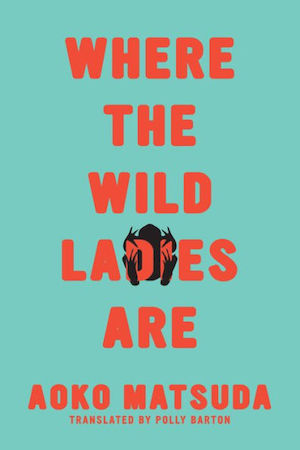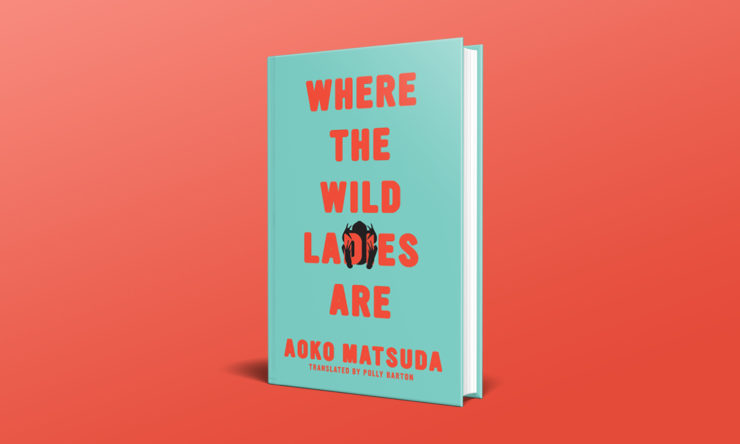Where the Wild Ladies Are by Aoko Matsuda (translated by Polly Barton) collects a set of linked short stories reimagining Japanese folktales in contemporary settings, shot through with exceptionally witty societal critique. Silent house-callers who watch over the babies of single mothers, lovers who must be scrubbed free of river mud each night, awkward but eerie saleswomen hawking lanterns, and vulpine shapeshifters to name a few feature in these tales… but rather than vengeful ghosts out to punish the living, Matsuda’s apparitions are complicated people in their own right with histories and interests.
Matsuda writes these tales of spirit(ed) women and dispirited men with impeccable comedic timing and a deceptively urbane tone that also carries biting commentary, while Barton’s translation maintains the rhythm of her prose with grace. The book is described as exuberant on the back cover, and the same word kept occurring to me. Wildness is dangerous but exuberant; these monstrous ladies are the same. At turns each might be kind, stubborn, careful, or cruel—but so might the living people they engage with and the world outside with its pressures around gender, respectability, class, and relationships.
One thing I kept thinking about as I read was how the book in an American publishing context functions on a few levels. How familiar is the reader with tales of youkai and yurei, with rakugo or kabuki performance, with contemporary Japanese urban life? Options abound from “not at all” to “very much so,” with those potential audiences each encountering the text from different standpoints. However, Matsuda’s deft melding of the mundane with the supernatural, for example the monotony of assembly-line labor with the shock or silliness of a ghostly visitation, opens the door for all sorts of readers to engage with the scope of these stories.
Buy the Book


Where the Wild Ladies Are
And whether or not the reader knows the tales Matsuda works from, the pieces stand together well—though familiarity with the original ghost stories adds a rich, playful texture to the experience. The short guide included at the close of the book is a good starting place for folks who want to know some background before diving in. I’d also suggest that unfamiliar American readers and/or white readers more broadly speaking, like me, note Matsuda’s through-going asides on Western cultural hegemony before attempting to stuff Where the Wild Ladies Are into a critical mold that better fits a white feminist approach, in the process erasing the parts that don’t “fit.”
Gender and its discontents are central to Where the Wild Ladies Are, for women but also men struggling under the pressures of societal expectations. Her precision in exploring a range of gendered experiences—without losing sight of the fact that though men suffer, women often suffer both those men and social pressure—reminds me of an essay I adored from The New Inquiry last year, “On Heteropessimism.” Matsuda’s stories critique the systems in place that create gendered inequalities and restrict women’s lives, damaging the potential for people to have good or equitable relationships. Many of the protagonists are heterosexual women who love men but are tired of them… while other stories feature men as the leads, such as the reoccurring character Shigeru who cannot find direction in his life or Shinzaburō of “The Peony Lanterns” who struggles to understand why his attempts to mind the rules his whole life have left him jobless and depressed.
The rules, and their strangling effect on people’s souls, are both a literal and metaphorical concern of the collection. Ghosts don’t come around without a powerful personal drive to continue on after death; one of the most challenging stories, “The Jealous Type,” takes the form of a second-person letter written to an abusive, violently jealous wife praising her for her tenacity of spirit and inviting her to take a place with Mr. Tei’s company after her passing. On a different note, the busybody aunt of the opening piece “Smartening Up” visits from the grave to lecture her niece about what a waste undergoing hair removal procedures for men is. That narrator then says, thinking about other stories she knows like Sadako from The Ring or historical ghost Okiku, “They all deserved credit. The ability to appear as a ghost was proof of an iron will.”
Gender is a rule; gender also attaches to other rules that spill out in a big mess. Most of the original tales Matsuda is working from center on the vengeful ghosts of women who were abused, preyed upon, or denied. These women were rendered monstrous in their reincarnations, come to wreak havoc on the world, but in these retellings the ghost herself is not the moral lesson. Instead, an examination of the world that created her and of the positive aspects of being “monstrous” by societal standards takes the stage—while Matsuda explores how being put into roles or boxes restricts a person’s life. Whether that’s the older woman who doesn’t realize she’s a fox shapeshifter until well into her middle age after putting up with office harassment and gendered roles for her youth, or the tree whose body is rendered “female” because of burrs that look like breasts and who resents that gendering, each story takes a different approach.
The one specifically queer story in the collection, “Quite a Catch,” speaks to the sensuality of monstrousness and its positivity between women in particular. The protagonist goes fishing with a friend and catches a skeleton; the ghost of the murdered girl then comes to visit her… and the two become lovers. She bathes her girlfriend free of river mud nightly and shares her delight with her single man friend neighbor, who’s a bit jealous but empathetic. (I also find it interesting that this is the one story where honorifics were left in, with the protagonist calling her ghostly lady lover “Hina-chan,” whereas in the other stories the signifiers have been removed or translated to Mr./Ms.) The story is tenderly fun, and I also appreciate their cameo in a later story where we learn she did successfully steal her girlfriend’s bones back from a museum.
Desire is a complicated, messy thing across all the stories. As someone cresting into their thirties utterly exhausted with dating, I found Matsuda’s wry and honest look at the limitations of desire and romance refreshing. Men and women in these stories wish for reciprocal partnerships, but the social order often stands in their path. However, there is also a quiet affection that comes through in some stories with more nontraditional relationships: “Having a Blast,” wherein a first wife, husband, and second wife all work together as ghosts at Mr. Tei’s factory and are enjoying their afterlives casually, for one. Or “The Missing One,” where an analogue for Okiku has a tender meet-cute over a missing plate with a kind man who clicks with her. Romantic love is a potentiality but so is violence—and so too is communal care, like the ghost who watches over a single mother’s child when the people around her won’t help.
Where the Wild Ladies Are is a fantastic book, and I’m holding myself off from talking endlessly about each story inside it. (Needs must acknowledge also: the physical book I’m holding in my hands has a gorgeous cover design.) Matsuda has done a stellar job of rendering her ghostly characters human and understandable, even the spookiest ones. Her human protagonists are also thoroughly relatable, whether depressed by the job market, their dating lives, or other pressures to fit in that are constricting them in their ability to desire. I read the collection cover to cover, then sifted through it again for a closer appreciation of the prose and the humor.
Where the Wild Ladies Are is available from Soft Skull Press.
Original publication in 2016 under the title おばちゃんたちのいるところ [Obachantachi no Iru Tokoro].
Lee Mandelo is a writer, critic, and editor whose primary fields of interest are speculative fiction and queer literature, especially when the two coincide. They have two books out, Beyond Binary: Genderqueer and Sexually Fluid Speculative Fiction and We Wuz Pushed: On Joanna Russ and Radical Truth-telling, and in the past have edited for publications like Strange Horizons Magazine. Other work has been featured in magazines such as Stone Telling, Clarkesworld, Apex, and Ideomancer.










